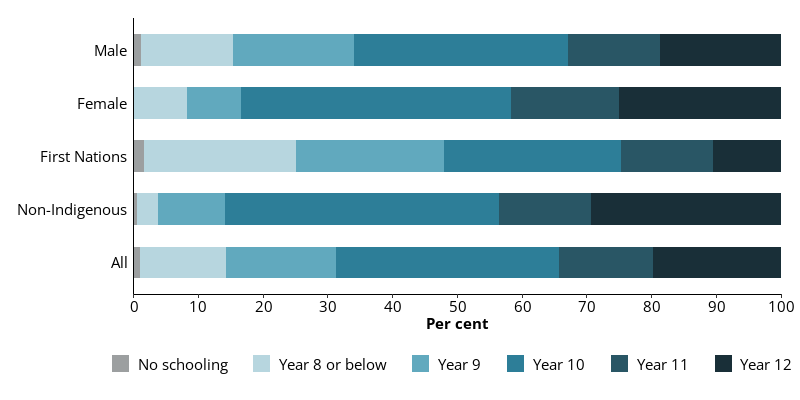Education
Education is a recognised social determinant of health, with lower levels of education associated with poorer health (Mitrou et al. 2014).
In 2021, 58% of people in the general community aged 17 and over reported completing year 12. Almost 1 in 10 (9.7%) people in the general community aged 15 and over were completing vocational education or undertaking a university degree or other higher education (ABS 2022).
While the prison population cannot be directly compared with the general community due to differences in age structure and other factors, tertiary qualifications are more prevalent in the community. In 2022, almost 2 in 5 (37%) people aged 20–64 in the general community reported attaining a bachelor’s degree or higher (ABS 2022).
People in prison have lower levels of educational attainment and higher levels of learning difficulty and learning disability than people in the general community (AIHW 2019; Kendall and Hopkins 2019; Skues et al. 2019).
Lower levels of educational attainment are associated with poorer employment opportunities and outcomes, and unemployment is a risk factor for incarceration and for re-offending after release (Baldry et al. 2018).
Education completed by prison entrants
Prison entrants were asked about the highest level of schooling they had completed and about any qualifications they had attained other than school.
For 1 in 3 (31%) prison entrants, the highest level of completed schooling was year 9 or under (Indicator 2.1.4).
Over two-thirds of prison entrants (69%) had completed schooling to year 10 or higher and 1 in 5 (20%) had completed the equivalent of year 12 (Figure 8.3).
For 13% of prison entrants, their highest level of schooling was year 8 or below.
Figure 8.3: Prison entrants, highest level of schooling completed, by sex and Indigenous identity, 2022

Notes
- Proportions are representative of prison entrants in this data collection, and not the entire prison population.
- Excludes Victoria, which did not provide data for this item.
Source: Entrants form, 2022 NPHDC.
Of 183 First Nations prison entrants, over half (52%) reported completing year 10 or higher, while 1 in 10 (10%) completed year 12. About a quarter of First Nations prison entrants (24%) reported their highest level of completed schooling as year 8 or below.
Of 184 non-Indigenous prison entrants, 86% reported completing year 10 or higher, while one-third reported completing year 12 (29%). One in 30 non-Indigenous entrants (3.3%) reported their highest level of completed schooling as year 8 or under.
Almost 2 in 5 (37%) prison entrants had completed a trade certificate, while more than a half (54%) had no formal education other than schooling.
One in 20 (5.1%) prison entrants were studying, either full time or part time, during the 30 days before entering prison.
Education at the tertiary level was not common – the highest level of completed education for entrants was a diploma (4.6%), followed by a bachelor’s degree (2.7%), and a postgraduate qualification (0.5%).
Education completed by prison dischargees
People in prison, particularly if sentenced, might be able to complete some study or a qualification. These educational attainments can improve self-confidence, have a positive impact on employment outcomes after release from prison, and reduce the likelihood of re‑offending (Baldry et al. 2018).
Prison dischargees were asked if they had completed any qualifications while in prison.
One in 4 (23%) prison dischargees reported completing a qualification while in prison (Indicator 2.1.5).
One in 5 (20%) prison dischargees reported that they finished a trade qualification while in prison, and 4.9% reported completing secondary school. Some dischargees completed more than one qualification while in prison.
First Nations dischargees (23%) and non-Indigenous dischargees (24%) were similarly as likely to report completing a qualification while in prison. Of First Nations dischargees, 4.5% reported completing secondary school, and 19% reported completing a trade certificate while in prison.
Of non-Indigenous dischargees, 5.2% reported completing secondary school, and 21% reported completing a trade certificate while in prison.
ABS (Australian Bureau of Statistics) (2022) Education and training: Census, ABS website, accessed 20 April 2023.
AIHW (Australian Institute of Health and Welfare) (2019) The health of Australia’s prisoners 2018, AIHW website, accessed 17 April 2023.
Baldry E, Bright D, Cale J, Day A, Dowse L, Giles M, Hardcastle L, Graffam J, McGillivray J, Newton D, Rowe S and Wodak J (2018) A future beyond the wall: improving post-release employment outcomes for people leaving prison: final report, University of New South Wales, Sydney.
Kendall A and Hopkins T (2019) ‘Inside out literacies: literacy learning with a peer-led prison reading scheme’, International Journal of Bias, Identity and Diversities in Education, 4(1):18.
Mitrou F, Cooke M, Lawrence D, Povah D, Mobilia E, Guimond E et al. (2014) ‘Gaps in Indigenous disadvantage not closing: a census cohort study of social determinants of health in Australia, Canada, and New Zealand from 1981–2006’, BMC Public Health 14:201.
Skues J, Pfeifer J, Olivia A and Wise L (2019) ‘Responding to the needs of prisoners with learning difficulties in Australia’, International Journal of Bias, Identity and Diversities in Education, 4(1):9.


